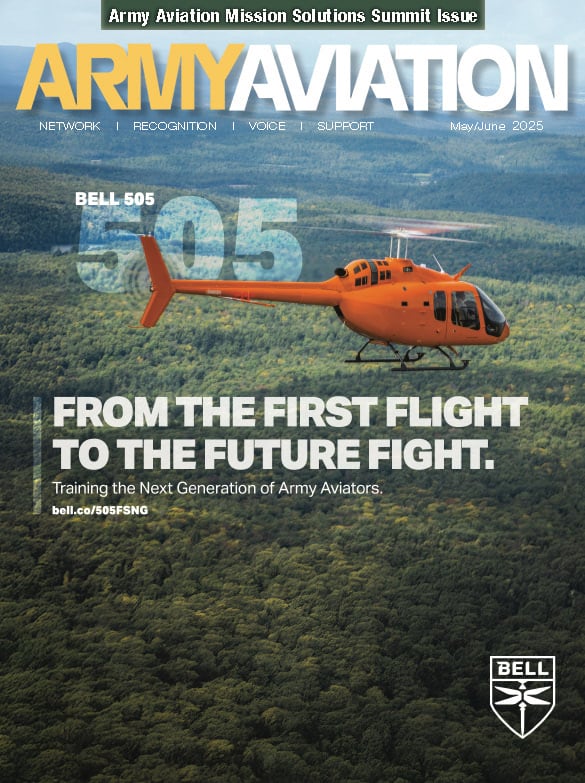Landing Zone
Fort Bragg All American DUSTOFF performs first in-flight prehospital blood transfusion
Story by Capt. Shervon Pope FORT BRAGG, N.C. -The “All American” DUSTOFF company executes first in-flight whole blood transfusion over Fort Bragg Apr. 30. Charlie Company of the 3-82 General Support Aviation Battalion (GSAB), 82nd Combat Aviation Brigade (CAB) is the first active Army unit to perform an in-flight prehospital blood transfusion outside a combat zone. Also known as the Fort Bragg “All American”, DUSTOFF Charlie Company conducts medical evacuation (MEDEVAC) operations year-round to support the installation and the surrounding area. DUSTOFF is an acronym that stands for Dedicated Unhesitating Service to Our Fighting Troops and is synonymous with life-saving...
Learn MoreChief Warrant Officer Circles the Globe in C-12 Huron
Story by Maj. Jeffrey Windmueller Chief Warrant Officer 4 Nicholas Demas was admiring the jagged peaks of the Swiss Alps cutting through the clouds when the radio crackled to life. “Be advised, you are going to be intercepted by a Swiss fighter jet for training purposes,” the voice said. Seconds later, an American-made F/A-18 Hornet appeared just 10 feet off his wingtip. Demas and his co-pilot snapped a quick photo, but the moment served as a stark reminder: this was no sightseeing trip. As an Army Reserve aviator, Demas was on a mission—flying halfway around the world to support Exercise...
Learn MoreArmy Successfully Tests In-Flight Life-Saving System for Incapacitated Pilots
OINT BASE LANGLEY-EUSTIS, Va. — Imagine a future where a UH-60 Blackhawk helicopter pilot, mid-flight, loses consciousness, and an onboard automated system reads the pilot’s vitals and autonomously flies the aircraft back safely, even alerting a medical crew to be at the airfield ready to treat the incapacitated pilot. A groundbreaking fusion joining autonomous flight and operational monitoring of pilots’ vital signs just made that future possibility a present-day reality recently at Joint Base Langley-Eustis, Virginia. “This is the first time we have integrated the pilot’s health status to an autonomous flight control system,” said Carl Ott, a U.S. Army...
Learn MoreFace of Defense: Father, Daughter Helicopter Pilots Fly Together
Army Warrant Officer Meghan Polis, a UH-60 Black Hawk helicopter pilot in the New York National Guard, doesn’t remember it but she logged her first three hours of helicopter flight time when she was just 3 months old. Her father — New York Army National Guard Chief Warrant Officer 3 Stephen Polis — and her mother were going to a barbecue in Albany. They lived on Long Island and they decided to make the trip north by air instead of driving. The flight school Stephen Polis worked for at the time as an instructor pilot allowed him to borrow a...
Learn MoreMisty Dawn Tests National Guard Large-Scale Combat Operations (LSCO)
Story by Master Sgt. Arthur Wright ELKINS, West Virginia — To ensure an understanding of Large-Scale Combat Operations (LSCO) and increasingly contested battlespace by adversaries, the District of Columbia National Guard led over 20 air and ground units across the U.S. Army and Air Force for exercise “Misty Dawn” in Elkins, West Virginia, between March 4-14, 2025. The joint readiness exercise highlighted coalition interoperability and high-end integrated tactics. “Misty Dawn is an apex example of grassroots, unit-led, readiness and lethality innovation – Right Now! When leadership tells units to get after readiness, move faster, and increase lethality; Misty Dawn is...
Learn MoreArmy Aviation
Looking Back
Looking Back: A monthly look into the history of Army Aviation based not only on the evolution of Army Aviation itself, but events in military history that certainly influenced the evolution of the Aviation Branch of the United States Army.
View ArchiveRover Joe, Horsefly, Timothy and Pineapple
Looking Back, June 2025 By Mark Albertson Rover Joe, Horsefly, Timothy and Pineapple As with any other endeavor that is from the mind of man, there is that period of trial and error until that level of efficiency is hopefully attained. This was certainly the case with trying to reach a functioning system of joint forward air controllers so as to provide the ground forces with effective close air support. Following the campaign in North Africa and the 35-day Sicilian operation that resulted in the removal of Axis forces, it was not until the Italian campaign that greater efforts were...
Learn More80th Anniversary of World War II: Army Aviation: The Pacific Theater
Looking Back, May 2025 By Mark Albertson 80th Anniversary of World War II: Army Aviation: The Pacific Theater Combat conditions in the Pacific Theater of Operations differed from those in the European Theater. From the start, the war in the West was, for the most part, of a conventional type: Infantry, artillery, armor, used on a scale not seen in the Pacific. From the North African Desert, onto Sicily, up the Italian boot and across the French countryside into Germany, armies were employed on a level conducive to the precepts of maneuver and mobility, combining ground power with airpower as...
Learn More












